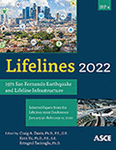Managing Debris Clearance from Road Transportation Networks after Earthquakes
Publication: Lifelines 2022
ABSTRACT
This research proposes a framework that allows to define a debris removal strategy from a road transportation network after a seismic event. The case study is a hypothetical large-scale city consisting of many interdependent infrastructure. Once the debris generated by the collapse of buildings have been estimated, blocked roads are identified. Cleanup operations are then prioritized based on road importance and travel time. The goal is to first verify that evacuation routes and important paths connecting strategic facilities such as hospitals, shelters, fire stations, etc., are available. In case some roads within these paths are blocked, alternative routes are considered. If the pre-event travel time does not significantly increase, clearing equipment and resources could be managed accordingly and directed towards other areas. The objective of this work is to help emergency managers to successfully improve disaster response avoiding delays during rescue and recovery operations.
Get full access to this article
View all available purchase options and get full access to this chapter.
REFERENCES
Al-Jarjees, S. D., and Al-Ahmady, K. K. (2020). “Planning the optimal debris removal of destroyed buildings in the Midan region in the Old City of Mosul.” Waste Management & Research, 38(4), 472-480.
Ambraseys, N. N., Simpson, K. U., and Bommer, J. J. (1996). “Prediction of horizontal response spectra in Europe.” Earthquake Engineering & Structural Dynamics, 25(4), 371-400.
Brown, C., Milke, M., and Seville, E. (2011). “Disaster waste management: A review article.” Waste management, 31(6), 1085-1098.
Brown, C. O., Hayes, J. L., and Milke, M. W. (2021). “Planning to adapt: identifying key decision drivers in disaster response planning.” Civil Engineering and Environmental Systems, 38(1), 20-35.
Çelik, M., Ergun, Ö., and Keskinocak, P. (2015). “The post-disaster debris clearance problem under incomplete information.” Operations Research, 63(1), 65-85.
Marasco, S., Cardoni, A., Noori, A. Z., Kammouh, O., Domaneschi, M., and Cimellarof, G. P. (2020). “Integrated platform to assess seismic resilience at the community level.” Sustainable Cities and Society, 102506.
Modica, M., Paleari, S., and Rampa, A. (2019). “Post earthquake debris and waste management in Italy. Extended Abstract.”
Özdamar, L., Aksu, D. T., and Ergüneş, B. (2014). “Coordinating debris cleanup operations in post disaster road networks.” Socio-Economic Planning Sciences, 48(4), 249-262.
Reinhart, D. R., and McCreanor, P. T. (1999). Disaster debris management–planning tools.
Zhang, F., Cao, C., Li, C., Liu, Y., and Huisingh, D. (2019). “A systematic review of recent developments in disaster waste management.” Journal of Cleaner Production, 235, 822-840.
Information & Authors
Information
Published In
History
Published online: Nov 16, 2022
Authors
Metrics & Citations
Metrics
Citations
Download citation
If you have the appropriate software installed, you can download article citation data to the citation manager of your choice. Simply select your manager software from the list below and click Download.
